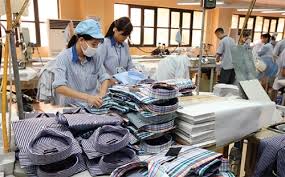
| TPP and the Vietnamese textile & garment story | |
If negotiating is successful, 95 percent of Vietnam’s textile and garment categories of exports to the US would enjoy the zero tariff. Meanwhile, 55 percent of the Vietnam’s total products go to the market. n the 18th round of negotiations within the Trans Pacific Partnership Agreement, taking place in Malaysia on July 15-25, the negotiations with the US on the textile and garment tariffs would be the toughest. China pleased, the US worried The Vietnam Textile and Garment Group (Vinatex) has asserted that Chinese would rush to Vietnam to set up textile and garment factories, once Vietnam’s garment exports enjoy the zero percent tariff within TPP. The businessman said if Vietnam’s fiber exports to the US also can enjoy the zero percent tariff within TPP, its current production capacity would be not big enough. South China Morning Post quoted Hong Tianzhu, President of Texhong Textile as saying that the group is considering expanding its investment in Vietnam. Chinese Pacific Textiles also plans to set up a joint venture with Hong Kong’s Crystal Group in Vietnam, capitalized at $180 million. Meanwhile, five days before the 18th round of negotiations began, Smyth McKissic, Chair of a national committee on textile and garment, said before the Congress that the trade agreements with Vietnam may threaten the US textile and garment industry with more than 500,000 workers. He has called on the US legislators to sign a letter to the US Trade Representative, requesting to maintain the current provision that all the textile and garment products must be made or outsourced in the countries which are the US’ free trade partners to be able to enjoy the tariff exemption when entering the US market. He warned that China would make products in Vietnam, where he believes the textile and garment industry receives subsidy from the government, and then takes full advantage of the preferential tariff to boost its exports to the US. To date, 160 congressmen from both the Democratic and Republic Parties have signed the letter. Big challenges for Vietnam According to Le Van Dao, Deputy Chair of the Vietnam Textile and Garment Association (Vinatas), the US has put forward some requests which could be the disadvantage for Vietnam. For example, the US side has set up the requirements on the materials of products, especially, the fiber needs to be imported from the US. If Vietnam has to satisfy the requirement, its products would find it difficult to enjoy the preferential tariff. Of the close production chain, from cotton growing to textile, dying and sewing, Vietnam only had big advantages in the latest link of the chain. With the current situation of the Vietnamese supporting industries, it’s obvious that the requirements on the material origin would only bring disadvantages to Vietnam. As such, the biggest beneficiaries in TPP would not be the Vietnamese producers. Some analysts have even commented that TPP only brings the opportunity for foreign investors, who consider Vietnam as a jumping board helping them jump into the vast markets that remain inaccessible to them. When giving pessimistic predictions about the TPP, they said that the added values Vietnam expects from the free trade agreements with other countries it has and will have in the future would be very insignificant. | |
| vietnamnet |
